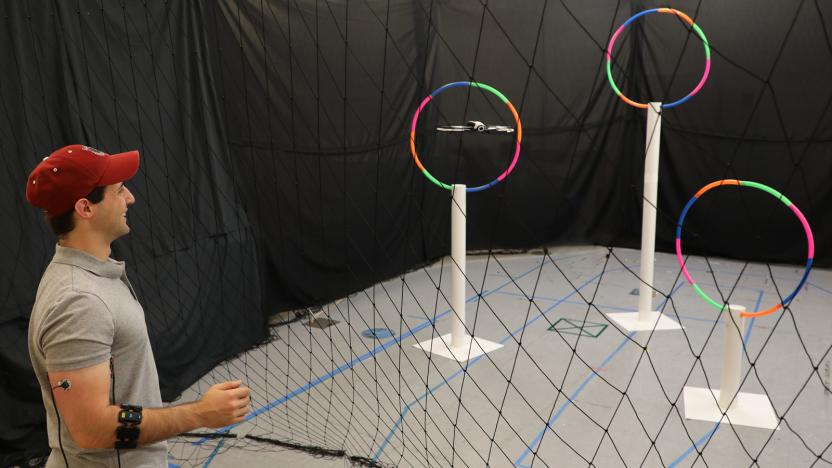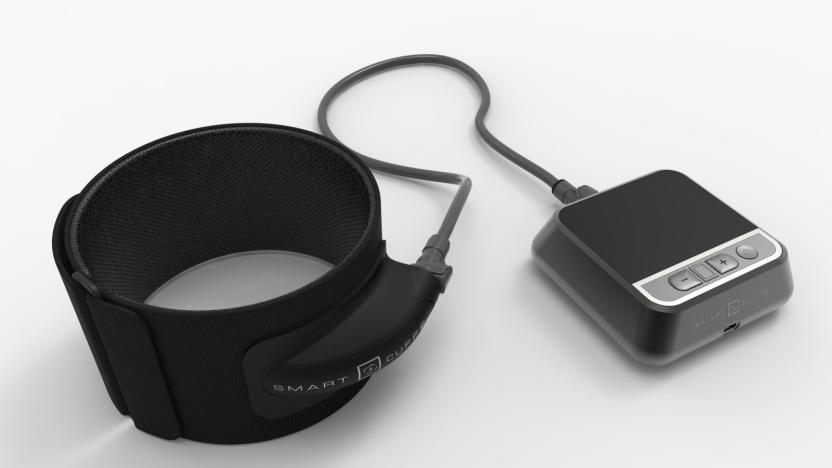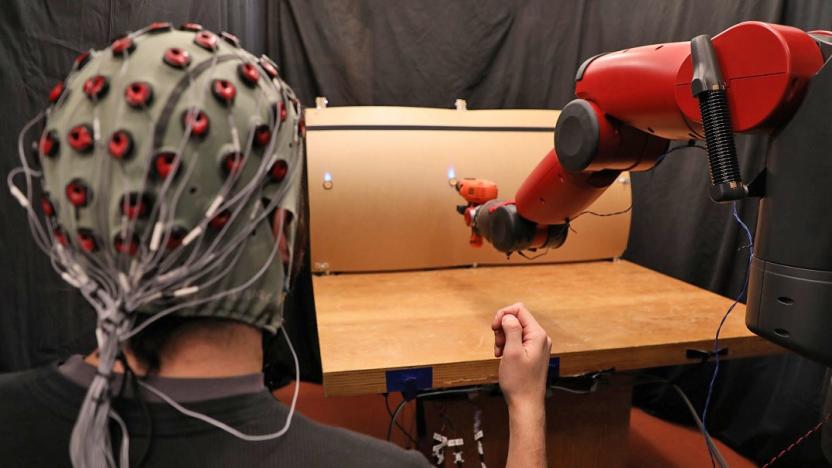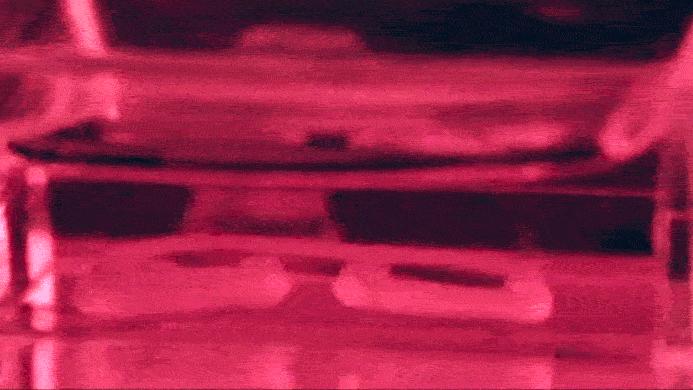muscle
Latest

Soft robotic device stimulates muscles, sparks hope for ALS and MS patients
Harvard researchers see a potential remedy for muscle atrophy in a new "mechanically active adhesive" that stretches and contracts the muscles of those unable to do so themselves.

Muscle sensors may let you control a drone by clenching your fist
MIT has developed a system that uses muscle sensors to control robots more intuitively.

Lab-grown heart muscles transplanted into a human for the first time
Researchers in Japan have successfully carried out the world's first transplant of lab-grown heart muscle cells, in a move which could significantly reduce the need for heart transplants. To grow the heart muscle cells, the scientists from Osaka University first took adult stem cells and reprogrammed back into their embryonic-like state. From this point, the researchers were able to coax the cells into becoming whatever form they wanted -- in this case, heart muscle cells.

SmartTools' updated weight lifting cuffs are cheaper and more durable
Bench pressing 200 pounds is cool, if you're into that, but it can put a strain on your limbs. SmartTools has an alternative. The company's SmartCuffs, blood flow restriction training (BFR) cuffs, let you lift less weight and see the same gains. While BFR training has primarily been used in clinical settings, the new SmartCuffs are meant for consumers and they're significantly more affordable than past iterations.

Synthetic fiber 'muscles' could lead to brawny robots and prosthetics
Most attempts at giving robots muscles tend to be heavy, slow or both. Scientists might finally have a solution that's both light and nimble, though. They've developed fibers that can serve as artificial muscles for robots while remaining light, responsive and powerful. They bonded two polymers with very different thermal expansion rates (a cyclic copolymer elastomer and a thermoplastic polyethylene) that reacts with a strong pulling force when subjected to even slight changes in heat. They're so strong that just one fiber can lift up to 650 times its weight, and response times can be measured in milliseconds.

MIT's 'RoboRaise' helps you lift things by studying your muscles
It's all well and good having a virtual assistant like Alexa or Siri in your lounge, but they make for a pretty useless robotic companion when it comes to shifting a sofa or getting a heavy box from a cupboard. MIT CSAIL has a solution in its sights though, and has developed a robot that can help lift things by studying a human's biceps.

MIT uses brain signals and hand gestures to control robots
Robotic technology has a staggering range of applications, but getting it to perform adequately can be a challenge, requiring specific programming based around the way humans communicate with language. But now, researchers from MIT have developed a way to control robots more intuitively, using hand gestures and brainwaves.

Origami-like soft robot can lift 1000 times its weight
Soft robotics allow machines to move in ways which mimic living organisms, but increased flexibility usually means reduced strength, which limits its use. Now, scientists at MIT CSAIL & Harvard have developed origami-like artificial muscles that add much-needed strength to soft robots, allowing them to lift objects as much as 1,000 times their own weight using only water or air pressure. One 2.6 gram muscle is able to lift a 3 kilogram object, which is the same as a duck lifting a car.

ICYMI: Submersible sticky situations and elongating elastomer electrodes
Today on In Case You Missed It: Researchers from Purdue University and the Office of Naval Research teamed up to develop a new kind of glue that even works underwater. The synthetic compound is derived from proteins used by muscles to keep themselves attached to rocks. The man-made adhesive is 17 times stronger than its source material and could one day hold US Navy ships together. We also take a look at a stretchable electrode developed at Stanford University. Leveraging the same kind of molecule that commercial kitchens use to thicken soups, the Stanford researchers were able to develop an electrical conductor that can be easily deformed while actually conducting better as it is stretched. And finally, this is what happens when you hook a watermelon up to a car battery. As always, please share any interesting tech or science videos you find by using the #ICYMI hashtag on Twitter for @mskerryd.

MIT builds low-cost synthetic muscles out of nylon cord
Researchers have been trying to build durable, low-cost synthetic muscles for years but to no avail. The systems developed so far have either been too expensive to produce en mass (like carbon nanotube) or too delicate and power hungry (looking at you, shape-memory alloys) to be useful outside of laboratory conditions. But a team from MIT have just struck upon the Goldilocks zone of robo-muscles with nylon fiber of all things.

Researchers create skeleton robot with human-like muscles
If robots that mimic animal or human behavior are your nightmare fuel, turn away now. Researchers at the Tokyo Institute of Technology went one step further with a skeleton robot, giving it human-like muscles to help with movement. The microfilament muscle "tissues" connect to joints and expand/contract just like the real thing. In fact, the robot has the same number of muscles in its legs as we do. At this point, they're not very strong and though the strands help with smoother movements, the skeleton still requires assistance to walk.

Watch tissue-based robots move in response to light
Researchers have modified muscle cells to move in response to light, which could eventually result in "bio-bots" useful for health or environmental applications. The breakthrough was made possible by the rapidly expand field of optogenetics, in which algae genes are spliced with muscle tissue from mice to make it sensitive to blue light. The team from the University of Illinois started with a 3D-printed hydrogel skeleton, then looped a ring of the modified tissue around. By firing a flash intermittently, they were able to make the muscle move, and even "exercise" it to become stronger.

Stretchable nanowire mesh heats your sore muscles
Don't like having to apply clunky heating pads every time you want to to deal with chronic muscle pain in your arms and legs? Eventually, you might not have to -- that therapeutic care could always be there. Korean researchers have developed a stretchable silver nanowire mesh that heats your joints no matter how you bend them. It's thin enough to fit under your clothes, runs on batteries and maintains a constant temperature, so you could wear the mesh whenever you're out instead of having to wait for prime opportunities to get relief.

Not all exoskeletons need motors to boost your strength
Robotic exoskeletons have their place, but not everyone needs to curl cinder blocks. You may just want to recover from an injury, for instance, or safely lift things on the job. Enter the "Sensorimotor Enhancing Suit (SEnS)" from Hiroshima University and Georgia Tech researchers. "Sensorimotor" refers to the relationship between muscles and nerves -- when your muscles strain to list heavy objects, they have a harder time sensing movement. The suit pulls off the double trick of reducing muscle load in your upper body and improving lifting coordination, without the cost and complexity of batteries and motors.

Muscle-sensing Myo gesture armband will be on Amazon this quarter
About a year after getting our first taste of the Myo, Thalmic Labs has announced that it's reaching out to the masses by way of Amazon this quarter. As with its pre-order on the company's website, this muscle-sensing gesture control armband will be available for $199. But even before that, Thalmic Labs has already sold 50,000 pre-orders (with about half of them shipped to buyers so far), which is a nice nod of approval to some of the use case examples showed off by Thalmic Labs and its several partners.

Lab-grown muscles could lead to personalized medicine
A team of researchers from Duke University have grown human skeletal muscles in the laboratory -- muscles that actually function and react to stimuli like their real counterparts. In order to do so, the scientists took cells that have already progressed beyond stem cells, placed them on a scaffolding with nourishment and waited for them to align into muscle fibers. That sounds easy written down, but the truth is they still had a tough time making it happen. According to one of the researchers, Lauren Madden, it took them "a year of adjusting variables like cell and gel density and optimizing the culture matrix and media" despite their experience growing animal muscles.

Artificial muscles lift 80 times their weight, pave the way for robot Superman
Other than a few models from Boston Dynamics, most robots don't exactly leave us quaking in fear. That might be off the table soon, though, thanks to a breakthrough from researchers at the National University of Singapore (NUS). They've developed polymer-derived artificial muscles that can stretch out up to five times in length, enabling them to lift 80 times their weight. That could one day result in life-like robots with "superhuman strength and ability," which could also run on very little power, according to the team. They expect to have a robotic limb that could smack down any human in arm-wrestling within five years -- putting a possible cyborg version of Over The Top alarmingly within reach.

DARPA developing muscle-controlled prosthetic limbs that can feel (video)
DARPA's no stranger to bionic limb research, however two new projects under the agency's RE-NET program focus on improving amputees' link to their prosthetics. RE-NET aims to develop the technology that will connect artificial limbs to existing nerves and muscles. Once that's achieved, users will be able feel with the prosthetic as well as move it as they would a real arm or leg, unlike another project focused on one-way control. Head past the break to watch videos documenting the clinical trials of both studies -- the arms in the clips aren't quite the life-like limbs DARPA promised back in 2006, but they sure are mighty impressive.

Turing machine built from artificial muscles may lead to smart prosthetics
In the hierarchy of computing hardware, artificial muscle doesn't really even register: it's usually a target for action, not the perpetrator. The University of Auckland has figured out a way to let those muscles play a more active role. Its prototype Turing machine uses a set of electroactive polymer muscles to push memory elements into place and squeeze piezoresistive switches, performing virtually any calculation through flexing. The proof-of-concept computer won't give silicon circuits any threat when it's running at just 0.15Hz and takes up as much space as a mini fridge, but the hope is to dramatically speed up and shrink down future iterations to where there are advanced computers that occupy the same size as real muscles. Researchers ultimately envision smart prosthetic limbs with near-natural reflexes, completely soft robots with complex gestures and even a switch from digital to analog computing for some tasks. Although we're quite a distance away from any of those muscle-bound ideas becoming everyday realities, it's good to at least see them on the horizon.

Alt-week 9.1.12: growing bones, repairing voices, and a pair of satellites
Alt-week peels back the covers on some of the more curious sci-tech stories from the last seven days. There's definitely more than a touch of a biological theme to proceedings this week. In fact, so much so that we thought we might well end up with enough ingredients to make our own cyborg. Or rather, a light-responding canine cyborg with a really cool voice. Yep, science and technology is working hard to make all of these things possible -- albeit independently. If science ever does do the right thing, and pool its resources on such a project, you can thanks us for the tip off. This is Alt-week.









